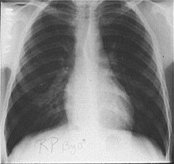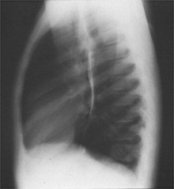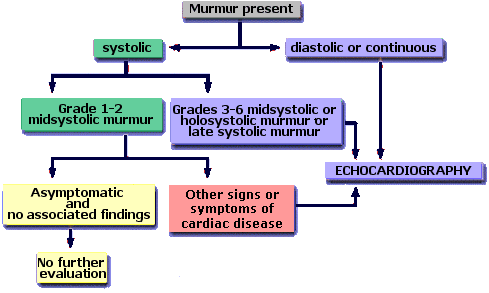|
|
[Skill Modules
>>
Heart Sounds & Murmurs
>>
Laboratory & Imaging
]
Laboratory and Imaging: Heart Sounds & Murmurs
Given the imperfect physical examination in diagnosing fluid overload and decreased left ventricular function, other studies are often helpful. These include radiography and echocardiography.
Radiography
| Normal chest x-ray with normal pulmonary veins |

Click to see larger image and use back button to return to content.*
|

Click to see larger image and use back button to return to content.* |
| Chest x-ray with pulmonary edema |

Click to see larger image and use back button to return to content.* |
| *Unless otherwise noted, all images are from the Cardiovascular Resources Videodisc. |
back to top
Echocardiography
Guidelines for Diagnostic Testing
(American College of Cardiology / American Heart Association (AHA))
Echocardiography Guidelines

Murmurs in ASYMPTOMATIC Individuals
| Echocardiography Recommendation |
Murmur Heard |
| Strong evidence or opinion in favor of Echo(I) |
Diastolic or continuous murmurs |
| Holosystolic or late systolic murmurs |
| Grade 3 or greater midsystolic murmurs |
| Conflicting evidence or opinion but generally favoring (IIa) |
Murmurs associated with abnormal physical examination findings on cardiac exam |
| Murmurs associated with abnormal EKG or chest x-ray |
| Evidence or opinion that not useful or may be harmful |
Grade 2 or softer midsystolic murmur identified as innocent |
Murmurs in SYMPTOMATIC Individuals
| Echocardiography Recommendation |
Murmur Heard |
| Strong evidence or opinion in favor of echo(I) |
Symptoms or signs of CHF, MI or syncope |
| Symptoms or signs consistent with infective endocarditis or thromboembolism |
| Conflicting evidence or opinion but generally favoring (IIa) |
Symptoms or signs most likely noncardiac but cardiac disease not excluded by standard evaluation. |
| Evidence or opinion that not useful or may be harmful |
Symptoms or signs most likely non cardiac with an isolated midsystolic"innocent" murmur. |
| Class I |
Conditions for which there is evidence and/or general agreement that a given procedure or treatment is useful or effective |
| Class II |
Conditions for which there is conflicting evidence and/or divergence of opinion about the usefulness/efficacy of a procedure or treatment agreement that a given procedure or treatment is useful or effective |
| Class IIa |
Weight of evidence/opinion is in factor of usefulness/efficacy |
| Class IIb |
Usefulness/efficacy is less well established by evidence/opinion |
| Class III |
Conditions for which there is evidence and/or general agreement that a given procedure is not useful and in some cases may be harmful |
|



